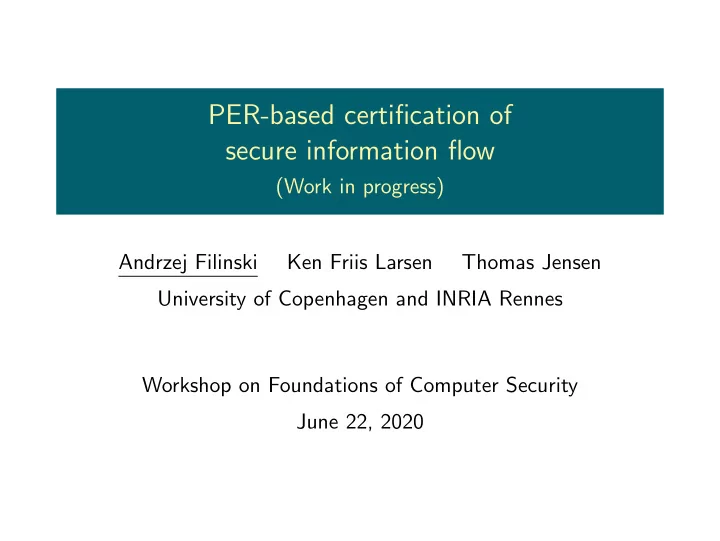

PER-based certification of secure information flow (Work in progress) Andrzej Filinski Ken Friis Larsen Thomas Jensen University of Copenhagen and INRIA Rennes Workshop on Foundations of Computer Security June 22, 2020
Background and motivation ◮ Goal: formally certifying safety and security of potentially malicious (or just buggy) mobile code. ◮ E.g., User-supplied kernel extensions for network-packet or syscall inspection (eBPF). ◮ “Safety”: protecting host’s own memory integrity from code. ◮ E.g., code may only read packet, and read/write scratch space. ◮ “No safety-policy violation is reachable .” ◮ PCC approach: native code + Floyd/Hoare-style safety proof. ◮ Complex safety policies expressible. ◮ In principle complete : all actually safe code is certifiably so. (Up to limits of formal reasoning about integer arithmetic.) ◮ “Security”: preventing leakage of potentially sensitive data made available to code by host. ◮ E.g., code may only look at certain packet fields/aspects. ◮ “No security-policy violation is observable .” ◮ Variety of information-flow logics/analyses exist. ◮ Often only coarse policies (e.g. high/low-security variables). ◮ Generally incomplete : actually secure code often uncertifiable.
PER-based safety&security policies ◮ Uniform framework for expressing safety and security. ◮ Partial : some states are impossible at given program point ◮ Equivalence Relation : some states must be indistinguishable at given program point. ◮ Can express complex security policies as relations on two instances of state, e.g., ◮ May observe everything about variable x , but only whether variable y is 0 or non-0. ◮ x 1 = x 2 ∧ ( y 1 = 0 ⇔ y 2 = 0). ◮ May observe whether purported checksum of sensitive data in packet is correct , but not the actual value of either. p 1 . d [ i ]) % 2 32 = p 1 . c ⇔ ( � | p 2 . d | p 2 . d [ i ]) % 2 32 = p 2 . c . ◮ ( � | p 1 . d | i =1 i =1 ◮ May observe all data in packet body, as long as header fields satisfy some conditions. ◮ ( p 1 . evil = p 2 . evil ) ∧ ( p 1 . evil ⇒ p 1 . payload = p 2 . payload ). ◮ Crucially: can express and argue safety&security of code in terms of its semantics/meaning only, not its form.
Certifying compliance with policy ◮ In most safety-critical applications (e.g., eBPF), mobile code must terminate in bounded time (to protect host availability ). ◮ May disregard termination-based information leakage. ◮ Correctness assertions of form { P } c { Q } , where P and Q are PERs, not merely predicates, on state space. ◮ Semantic correctness: functional meaning of program is a PER morphism , i.e., maps precondition-related inputs to postcondition-related outputs. ◮ Provable correctness: reducible to ordinary Floyd/Hoare logic (with ghost variables for relating inputs to outputs). ◮ Weakest precondition: needed observability of inputs, to support postcondition-allowed observation of outputs. ◮ Must be semantically implied by actual precondition. ◮ Most of required infrastructure already present in plain PCC. ◮ In particular, no significant enlargement of TCB needed. ◮ Can rephrase many type-based IF logics as special cases. ◮ More soon!
Recommend
More recommend